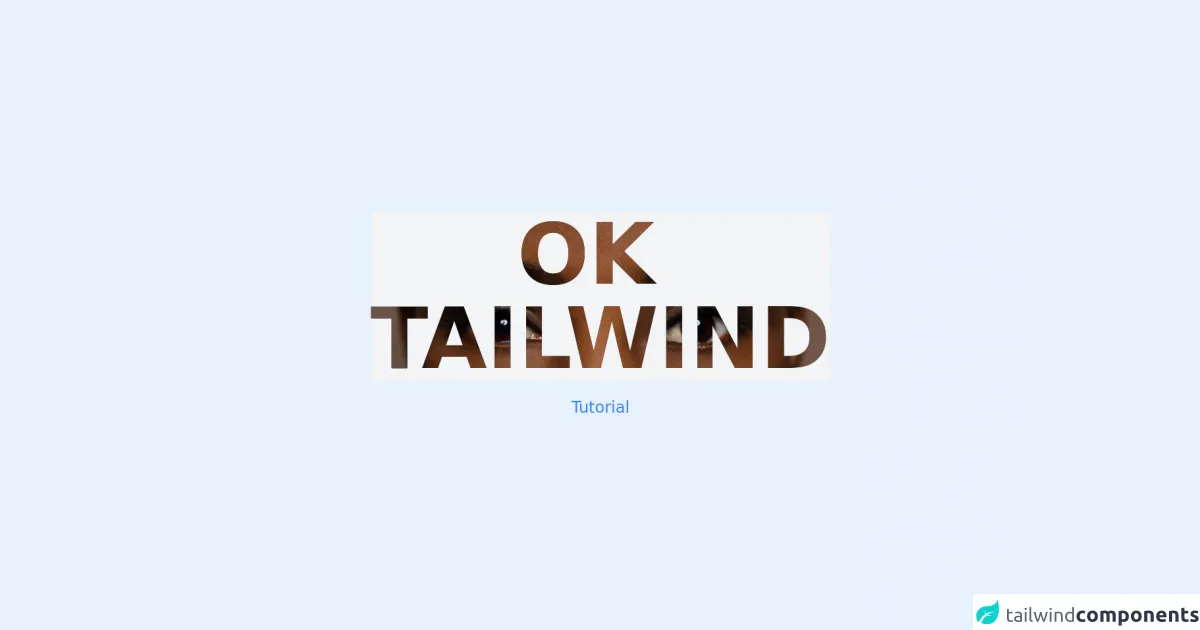- Published on
What You Need To Create A How To Embed The Image In A Text With Tailwindcss ? With Tailwind CSS

- What is Tailwind CSS?
- The description of How to embed the image in a text with Tailwindcss ? ui component
- Why use Tailwind CSS to create a How to embed the image in a text with Tailwindcss ? ui component?
- The preview of How to embed the image in a text with Tailwindcss ? ui component.
- The source code of How to embed the image in a text with Tailwindcss ? ui component.
- How to create a How to embed the image in a text with Tailwindcss ? with Tailwind CSS?
- Conclusion
What is Tailwind CSS?
Tailwind CSS is a utility-first CSS framework that allows developers to quickly build custom user interfaces. It provides a set of pre-defined CSS classes that can be used to style HTML elements. With Tailwind CSS, developers can easily create complex designs without writing custom CSS code.
The description of How to embed the image in a text with Tailwindcss ? ui component
The "How to embed the image in a text with Tailwindcss?" UI component is a common feature in many web applications. It allows users to add images to their text content and display them in a visually appealing way. This UI component is easy to create with Tailwind CSS.
Why use Tailwind CSS to create a How to embed the image in a text with Tailwindcss ? ui component?
Tailwind CSS provides a set of pre-defined CSS classes that can be used to style HTML elements. This makes it easy to create complex designs without writing custom CSS code. It also provides a responsive design system that allows developers to create designs that work well on all screen sizes.
The preview of How to embed the image in a text with Tailwindcss ? ui component.
To create a "How to embed the image in a text with Tailwindcss?" UI component, we will use the Tailwind CSS classes to style the HTML elements. The component will consist of a text area and an image area. The image will be embedded in the text area and will be displayed in a visually appealing way.
Free download of the How to embed the image in a text with Tailwindcss ?'s source code
The source code of How to embed the image in a text with Tailwindcss ? ui component.
To create the "How to embed the image in a text with Tailwindcss?" UI component, we will use HTML and Tailwind CSS classes. The HTML code will consist of a text area and an image area. The Tailwind CSS classes will be used to style the HTML elements and create the desired design.
<style>
.tailwindccsok {
background-image : url('https://th.bing.com/th/id/R.9fec627c14e4139d329eb1e89c750de6?rik=EroFSldai0o6Ug&riu=http%3a%2f%2fwww.peimag.com%2fwp-content%2fuploads%2f2015%2f10%2fblack-eyes2.jpg&ehk=r1dQ5fzKeg0ILkaX5esbRxeZolXZamBKJN6VUezk3wY%3d&risl=&pid=ImgRaw');
background-size: cover;
background-repeat: no-repeat;
}
</style>
<div class="flex flex-col justify-center items-center h-screen">
<div class="tailwindccsok text-center">
<h1 class="font-black text-9xl bg-gray-100 mix-blend-lighten uppercase">Ok <br> Tailwind</h1>
</div>
<a href="https://www.youtube.com/watch?v=kdQLflg1ZC0&t=12s&ab_channel=e.Michel" class="text-blue-500 text-2xl mt-6">Tutorial </a>
</div>
How to create a How to embed the image in a text with Tailwindcss ? with Tailwind CSS?
To create a "How to embed the image in a text with Tailwindcss?" UI component with Tailwind CSS, follow these steps:
- Create a new HTML file and add a text area and an image area to it.
<div class="flex flex-wrap">
<div class="w-full md:w-3/4 p-4">
<textarea class="w-full h-64 border rounded p-2"></textarea>
</div>
<div class="w-full md:w-1/4 p-4">
<div class="relative h-64">
<img class="absolute top-0 left-0 w-full h-full object-cover rounded" src="https://via.placeholder.com/300x200" alt="Placeholder Image">
</div>
</div>
</div>
- Add the Tailwind CSS classes to style the HTML elements.
<div class="flex flex-wrap">
<div class="w-full md:w-3/4 p-4">
<textarea class="w-full h-64 border rounded p-2"></textarea>
</div>
<div class="w-full md:w-1/4 p-4">
<div class="relative h-64">
<img class="absolute top-0 left-0 w-full h-full object-cover rounded" src="https://via.placeholder.com/300x200" alt="Placeholder Image">
</div>
</div>
</div>
- Customize the design by modifying the Tailwind CSS classes.
<div class="flex flex-wrap">
<div class="w-full md:w-3/4 p-4">
<textarea class="w-full h-64 border rounded p-2"></textarea>
</div>
<div class="w-full md:w-1/4 p-4">
<div class="relative h-64">
<img class="absolute top-0 left-0 w-full h-full object-cover rounded" src="https://via.placeholder.com/300x200" alt="Placeholder Image">
<div class="absolute bottom-0 right-0 p-2 bg-gray-900 text-white rounded">
<span class="text-xs">Photo by John Doe</span>
</div>
</div>
</div>
</div>
- Add the image and text content dynamically using JavaScript.
<div class="flex flex-wrap">
<div class="w-full md:w-3/4 p-4">
<textarea id="textArea" class="w-full h-64 border rounded p-2"></textarea>
</div>
<div class="w-full md:w-1/4 p-4">
<div class="relative h-64">
<img id="image" class="absolute top-0 left-0 w-full h-full object-cover rounded" src="" alt="">
<div id="imageCaption" class="absolute bottom-0 right-0 p-2 bg-gray-900 text-white rounded">
<span id="imageCredit" class="text-xs"></span>
</div>
</div>
</div>
</div>
<script>
const textArea = document.getElementById("textArea");
const image = document.getElementById("image");
const imageCredit = document.getElementById("imageCredit");
textArea.addEventListener("input", () => {
const imageUrl = extractImageUrl(textArea.value);
if (imageUrl) {
image.src = imageUrl;
imageCredit.innerText = extractImageCredit(textArea.value);
} else {
image.src = "";
imageCredit.innerText = "";
}
});
function extractImageUrl(text) {
const regex = /!\[(.*?)\]\((.*?)\)/;
const match = text.match(regex);
return match ? match[2] : null;
}
function extractImageCredit(text) {
const regex = /Photo by (.*?)\n/;
const match = text.match(regex);
return match ? match[1] : "";
}
</script>
Conclusion
In conclusion, creating a "How to embed the image in a text with Tailwindcss?" UI component is easy with Tailwind CSS. By using pre-defined CSS classes, developers can quickly create complex designs without writing custom CSS code. With the addition of JavaScript, the component can be made dynamic and allow users to add images to their text content in a visually appealing way.